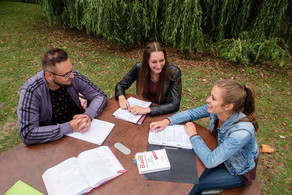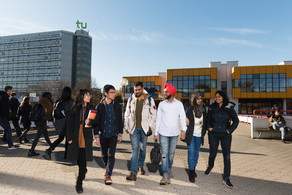Inforeihe Part 1: Find new routines
Start work
The basic skills of general work organization do not differ significantly from work organization in the home office. Nevertheless, the organization of work is now once again of particular importance. Therefore: Before you start with the actual work, take time to set up your workplace - not only in the physical sense. Ask yourself the questions: What do I need to work well and what has always worked for me so far? How can I transfer these things to the home office? Try your hand at it and, with a little time, find new routines that work for you.
Structure your day and week well in advance. Use a weekly schedule to determine when you start and when you finish your activity. Define break times, find solutions for professional and informal exchange with colleagues (setting a phone appointment with the team? Networking via a group chat? A shared email distribution list?). After all, priorities can shift and routines become challenges that need to be rethought, and you are probably not alone in facing them. So share ideas as a team and learn from each other.
Well-chosen daily and weekly goals can significantly increase intrinsic motivation. The SMART principle for setting good goals can be helpful here. Following the principle, goals should meet the following criteria:
- "S"pecific
- "M"edible
- "A"ttractive
- "R"ealistic
- "T"ermined
It is important to regularly evaluate goals and their achievement. How you can do this is explained in the subsection "Finishing the job".
During work
The daily office routine often provides for fixed and jointly spent break times. Now it's up to you to maintain and design these important recovery phases completely autonomously. The following can be helpful here: divide a long work unit into smaller work units and provide them with work content that correlates with your daily goals. Ideally, you should divide the morning into two to four clearly defined work units until the break and the afternoon until the end of the day.
And what do you do during the breaks? You relax, you exercise a little, or you combine the two directly. How do you do that? Here are three mini exercises:
Sit comfortably, feet on the floor, with eyes closed or firmly focused on a point in the room, slowly and consciously breathe in. Feel how the breath flows in and out, what changes in the body as a result, where you feel the breath. Duration: 1 -5 minutes.
Finish with the work
The separation of working time and free time is very important in order to be able to build up resources in the long term and to remain productive. However, this separation is challenging and incomparably more demanding when the workplace is also the center of life. But the aids that are applied in the regular workday can also be transferred to the home office. These are boundary tactics (strategies to promote mental detachment).
For example, leave the workplace in a ritualized manner. Clean up the workplace as the last step in your work or consciously shut down the PC. In this way, you help to teach your brain: Now the end of work begins! Evaluate your workday and the achievement of your goals. Here it is important to make sure to evaluate in a results AND process-oriented way to keep frustrations at a minimum. What does this mean? Look at your work results and openly elicit why something worked or didn't work and conclude alternative actions for the coming day. Consciously appreciate the processes you have completed.
Remain strict: the end of work is the end of work. Like a good goal, this one is scheduled and variable only in narrow exceptions. Shield your recovery from disruptive factors: To do this, make arrangements with your team where possible about when you are available and when you are not. During the work small breaks may not be missing. But how do you realize the big break after work, which is usually reserved for your sports course or the gym? The TU Dortmund University Sports Center has an exciting offer here: every weekday, an entire sports class is streamed live on social media (Instagram, Facebook), and another streaming alternative via the Internet is being planned. At lunchtime, a moving break is also streamed on weekdays in the form of the break express. This is also a nice opportunity to do something "together" with colleagues and to talk about it afterwards. Why don't you give it a try!
At a glance - basic tips for working successfully from home
- Start and end your workday at the same times if possible
- Structure your day and week before you start working (weekly plan; SMART principle)
- Take regular and conscious breaks (break up work phases; mindfulness mediation, moving break)
- Stay in contact, replace collegial exchange with regular phone calls
- Separate work time and private time with small rituals (boundary tactics)
- Stay athletic, university sports stream daily classes that are fun and keep you fit
WE ARE HERE FOR YOU!
If you have any questions about the tips above, would like to know more exercises, or would like to talk about something else entirely, please email us: Email Psychological Student Counseling. We will call you back promptly for an initial phone conversation.
Your team of the Psychological Study Counseling





![[Translate to English:] Partner Four hands are holding the green logo of TU Dortmund University](/storages/tu_website/_processed_/1/d/csm_Partner_Nicole_Rechmann_KW_670eba0154.jpg)




![[Translate to English:] Forschung An apparatus with tubes in a laboratory](/storages/tu_website/_processed_/0/c/csm_Forschung_Juergen_Huhn_4fa3153b51.jpg)
![[Translate to English:] Studium Five students are sitting in a lecture hall. They are talking to each other.](/storages/tu_website/_processed_/c/9/csm_Studium_FelixSchmale_dbdbfb0dd7.jpg)





